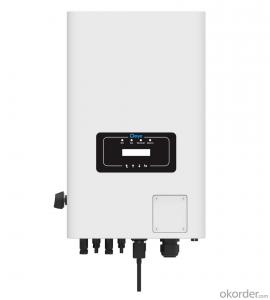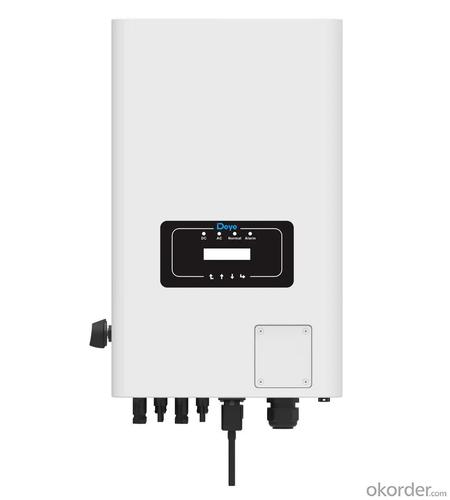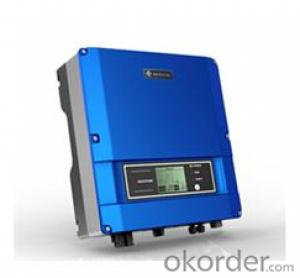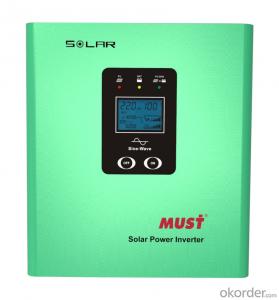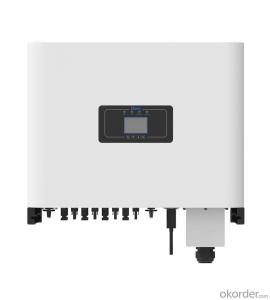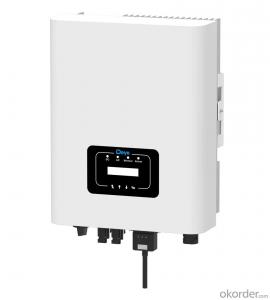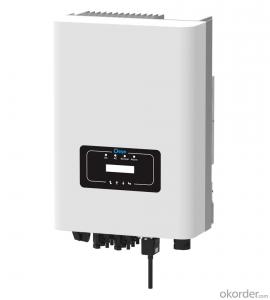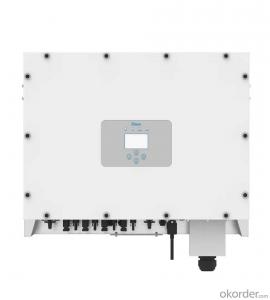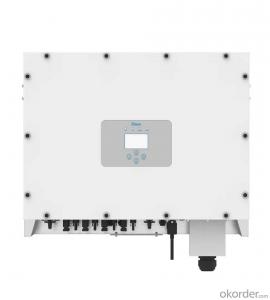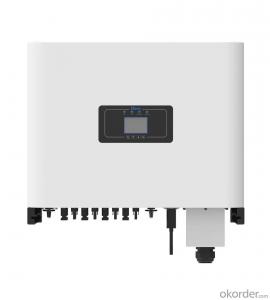Bosch Solar Inverter sun-30/33/36k-g04 | 30-36kw | Three Phase | 2 MPPT
- Loading Port:
- Ningbo
- Payment Terms:
- TT OR LC
- Min Order Qty:
- 100 pc
- Supply Capability:
- 5000 pc/month
OKorder Service Pledge
OKorder Financial Service
You Might Also Like
Specification
| Model | SUN-30K-G04 | SUN-33K-G04 | SUN-36K-G04 |
| Input Side | |||
| Max. DC Input Power (kW) | 39 | 42.9 | 46.8 |
| Max. DC Input Voltage (V) | 1000 | ||
| Start-up DC Input Voltage (V) | 250 | ||
| MPPT Operating Range (V) | 200~850 | ||
| Max. DC Input Current (A) | 40+40 | ||
| Max. Short Circuit Current (A) | 60+60 | ||
| Number of MPPT / Strings per MPPT | 2 / 4 | ||
| Output Side | |||
| Rated Output Power (kW) | 30 | 33 | 36 |
| Max. Active Power (kW) | 33 | 36.3 | 39.6 |
| Rated AC Grid Voltage (V) | 220 / 380, 230 / 400 | ||
| AC Grid Voltage Range (V) | 277Vac~460Vac (this may vary with grid standards) | ||
| Rated Grid Frequency (Hz) | 50 / 60 (Optional) | ||
| Operating Phase | Three phase | ||
| Rated AC Grid Output Current (A) | 43.5 | 47.8 | 52.2 |
| Max. AC Output Current (A) | 47.8 | 52.6 | 57.4 |
| Output Power Factor | 0.8 leading to 0.8 lagging | ||
| Grid Current THD | <3% | ||
| DC Injection Current (mA) | <0.5% | ||
| Grid Frequency Range | 47~52 or 57~62 (Optional) | ||
| Efficiency | |||
| Max. Efficiency | 98.6% | ||
| Euro Efficiency | 97.8% | ||
| MPPT Efficiency | >99% | ||
| Protection | |||
| DC Reverse-Polarity Protection | Yes | ||
| AC Short Circuit Protection | Yes | ||
| AC Output Overcurrent Protection | Yes | ||
| Output Overvoltage Protection | Yes | ||
| Insulation Resistance Protection | Yes | ||
| Ground Fault Monitoring | Yes | ||
| Anti-islanding Protection | Yes | ||
| Temperature Protection | Yes | ||
| Integrated DC Switch | Yes | ||
| Remote software upload | Yes | ||
| Remote change of operating parameters | Yes | ||
| Surge protection | DC Type II / AC Type II | ||
| General Data | |||
| Size (mm) | 362W×577H×215D | ||
| Weight (kg) | 25.5 | ||
| Topology | Transformerless | ||
| Internal Consumption | <1W (Night) | ||
| Running Temperature | -25~65℃ | ||
| Ingress Protection | IP65 | ||
| Noise Emission (Typical) | <45 dB | ||
| Cooling Concept | Smart cooling | ||
| Max. Operating Altitude Without Derating | 2000m | ||
| Designed Lifetime | >20 years | ||
| Grid Connection Standard | EN50549-1,VDE 0126-1-1 | ||
| Operating Surroundings Humidity | 0-100% | ||
| Safety EMC / Standard | IEC62109-1/-2,IEC61000-6-2,IEC61000-6-4 | ||
| Features | |||
| DC Connection | MC-4 mateable | ||
| AC Connection | IP65 rated plug | ||
| Display | LCD 1602 | ||
| Interface | RS485/RS232/Wifi/LAN | ||
This new series of three-phase output inverter has wider range of 30kw, 33kw, 36kw than the original series, at the same time still got two integrated MPPTs, allowing two-array to input from different roof orientations. In addition, it allows the system to be monitored and controlled remotely.
2 MPP tracker, Max. efficiency up to 98.6%
Zero export application, VSG application
String intelligent monitoring (optional)
Wide output voltage range
Anti-PID function (Optional)
- Q: Can a solar inverter be used for both single-phase and three-phase applications?
- No, a solar inverter cannot be used for both single-phase and three-phase applications. Different types of inverters are designed specifically for either single-phase or three-phase systems, as they have different voltage and power requirements.
- Q: What is the role of a solar inverter in preventing electrical faults?
- The role of a solar inverter in preventing electrical faults is to convert the direct current (DC) generated by solar panels into alternating current (AC) that can be used to power electrical devices. By regulating the voltage and frequency of the AC output, it ensures that the electrical power is stable and suitable for consumption. Additionally, solar inverters have built-in protective features such as ground fault protection, overvoltage protection, and short-circuit protection, which help detect and prevent electrical faults that may occur within the solar power system.
- Q: What is the role of capacitors in a solar inverter?
- The role of capacitors in a solar inverter is to store and release electrical energy. They help to stabilize the voltage and current, ensuring a smooth and continuous flow of power. Capacitors also help to filter out any unwanted noise or fluctuations in the electrical signal, thus improving the overall performance and efficiency of the solar inverter.
- Q: How does a solar inverter handle voltage dips or fluctuations in the grid?
- A solar inverter handles voltage dips or fluctuations in the grid by constantly monitoring the grid voltage. When it detects a dip or fluctuation, it rapidly adjusts its output voltage to stabilize the grid voltage. This process is known as grid support or grid-tied operation and ensures that the solar inverter maintains a steady and synchronized connection with the grid, even during voltage disturbances.
- Q: Can a solar inverter be used in a solar-powered street lighting system?
- Yes, a solar inverter can be used in a solar-powered street lighting system. A solar inverter is responsible for converting the direct current (DC) produced by solar panels into alternating current (AC) that can be used to power the street lights. Therefore, it plays a vital role in ensuring that solar energy is efficiently utilized in the lighting system.
- Q: What is the role of a maximum power point tracker (MPPT) in a solar inverter?
- The role of a maximum power point tracker (MPPT) in a solar inverter is to optimize the efficiency and power output of a solar panel system. Solar panels generate direct current (DC) electricity, but most appliances and the electrical grid operate on alternating current (AC). The MPPT is responsible for continuously adjusting the operating conditions of the solar panels to extract the maximum power available from the sunlight. It tracks the maximum power point (MPP) at which the solar panels can generate the most electricity efficiently. This is important because the output of a solar panel is highly dependent on factors such as temperature, shading, and the angle of the sun. By continuously monitoring and adjusting the voltage and current of the solar panel system, the MPPT ensures that the solar panels are always operating at the MPP, maximizing the power output. It achieves this by dynamically changing the electrical load on the solar panels to find the optimal operating point. The MPPT also acts as a converter, transforming the DC power generated by the solar panels into the AC power required for use by appliances or for feeding back into the electrical grid. This conversion process involves transforming the voltage and frequency of the electricity to match the requirements of the appliances or the grid. Overall, the role of a maximum power point tracker in a solar inverter is to optimize the efficiency and power output of the solar panel system, ensuring that the maximum amount of energy is harnessed from the sunlight and effectively utilized for various applications.
- Q: Can a solar inverter be used with a time-of-use electricity tariff?
- Yes, a solar inverter can be used with a time-of-use electricity tariff. Time-of-use electricity tariffs typically involve different rates for electricity consumption based on the time of day. A solar inverter can be programmed to produce and export excess solar energy during peak times when electricity rates are higher, and import energy from the grid during off-peak times when rates are lower. This allows users to optimize their energy consumption and potentially save on electricity costs.
- Q: How does a solar inverter convert DC to AC power?
- A solar inverter converts DC (direct current) power generated by solar panels into AC (alternating current) power that is compatible with household and grid electricity. It does this by utilizing electronic components such as transistors and capacitors to convert the fixed voltage and current of DC power into a fluctuating form that resembles the waveform of AC power. The inverter then boosts the voltage to the desired level and synchronizes the frequency of the AC power with the grid's frequency before feeding it into the electrical system.
- Q: What is the role of a fault detection feature in a solar inverter?
- The role of a fault detection feature in a solar inverter is to monitor and identify any malfunctions or abnormalities within the system. It is responsible for detecting faults such as overvoltage, under-voltage, over-temperature, short circuits, ground faults, or any other potential issues that may arise. This feature helps ensure the safe and efficient operation of the solar inverter by promptly alerting the user or system operator about the fault, allowing for quick troubleshooting and maintenance.
- Q: Can a solar inverter be used in remote areas without access to the grid?
- Yes, a solar inverter can be used in remote areas without access to the grid. Solar inverters are designed to convert the direct current (DC) electricity generated by solar panels into alternating current (AC) electricity that can be used to power electrical devices. In remote areas, solar inverters can be used to harness the energy from the sun and provide a reliable and sustainable source of electricity, without the need for a connection to the grid.
Send your message to us
Bosch Solar Inverter sun-30/33/36k-g04 | 30-36kw | Three Phase | 2 MPPT
- Loading Port:
- Ningbo
- Payment Terms:
- TT OR LC
- Min Order Qty:
- 100 pc
- Supply Capability:
- 5000 pc/month
OKorder Service Pledge
OKorder Financial Service
Similar products
Hot products
Hot Searches
Related keywords
